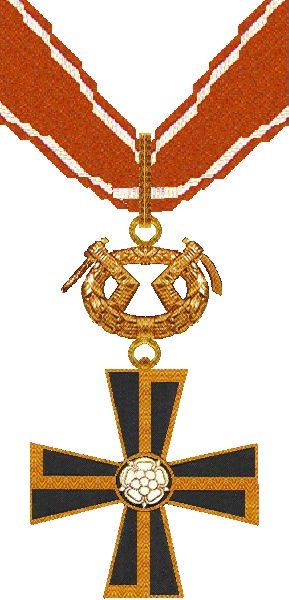Military awards and decorations facts for kids
Military awards and decorations are special honors given to people in the military. They show that someone has been very brave, done excellent work, or achieved something important. Often, a decoration is a medal with a ribbon and a round piece of metal called a medallion.
Sometimes, people in the military also receive awards that are for civilians (people not in the military). These are not considered military decorations. Awards given to police officers or fire brigade members might look like military awards, but they are not strictly military.
Military awards can be worn as medal ribbons or smaller versions of the medals. These are usually put together on a bar.
Contents
History of Military Awards
People have been giving out awards for a very long time. In ancient Egypt, there was the Order of the Golden Collar. Later, the New Kingdom gave out the Order of the Golden Fly. Ancient Celts and Romans wore special necklaces called torcs or received other military decorations like the hasta pura, which was a spear without a sharp tip. Some groups, like the Dayaks, used tattoos as awards.
In the early Middle Ages, people received necklaces and bracelets as honors. These later became large, fancy necklaces with many gemstones, often with a pendant (like a medal) hanging from them.
Oldest Awards Still Used
Some of the oldest military awards that are still officially active today include:
- Sweden's För tapperhet i fält (meaning 'For Valour in the Field') and För tapperhet till sjöss ('For Valour at Sea'). These were created by King Gustav III in 1789 during a war with Russia. They are given to Swedish soldiers and officers who show bravery in battle. While still active, they haven't been awarded since 1915.
- The Austro-Hungarian Tapferkeits Medaille (Honor Medal for Bravery). Emperor Joseph II started this medal on July 19, 1789.
- Poland's War Order of Virtuti Militari (meaning 'For Military Valour' in Latin). This award was first given out in 1792.
Fake Medals
Sometimes, people try to make fake medals. They might do this to make a medal seem more valuable or to pretend they are a more decorated soldier than they really are. Making fake medals can involve:
- Adding extra bars to a medal.
- Engraving a famous soldier's name on it.
- Creating a completely new medal.
Making fake medals is against the law in most countries. People who do this can face serious punishments, like going to prison.
Modern Military Awards
Today, military awards come in many forms:
- Orders of merit: These are high honors given for outstanding service.
- Bravery awards: These often look like a cross, star, or medal on a ribbon.
- Distinguished service awards: These are also crosses, stars, or medals on a ribbon, given for excellent service.
- Campaign medals: These are worn on a ribbon and given for taking part in specific military campaigns or wars.
- Service medals: These are worn on a ribbon and given for general service.
- Awards for entire units: Sometimes, a whole group of soldiers gets an award. These can be battle honours, campaign streamers, special ropes called fourragères, or unit citations.
In many modern armies, especially those in NATO, soldiers usually wear only the small service ribbons on their everyday uniforms, not the actual medals.
Examples of Awards by Country
Many countries have their own unique military awards. Here are a few examples:
- Commonwealth Realms orders and decorations (like those in the UK, Canada, Australia)
- Orders, decorations, and medals of Belgium
- Awards and decorations of the German Armed Forces
- Awards and decorations of the Indian Armed Forces
- Israeli military decorations
- Awards and decorations of the Russian Federation
- Awards and decorations of the Soviet Union (from the former Soviet Union)
- Orders, decorations, and medals of Spain
- Orders, decorations, and medals of the United Kingdom
- Awards and decorations of the United States military
See also
 In Spanish: Distinción militar para niños
In Spanish: Distinción militar para niños



